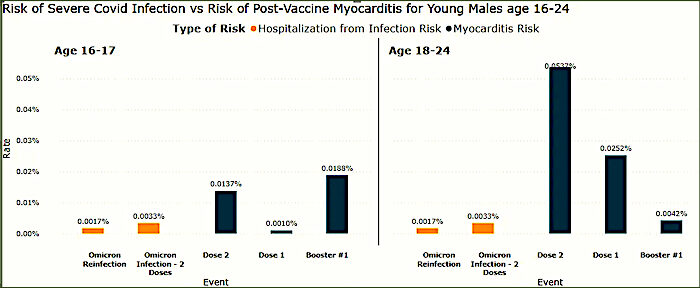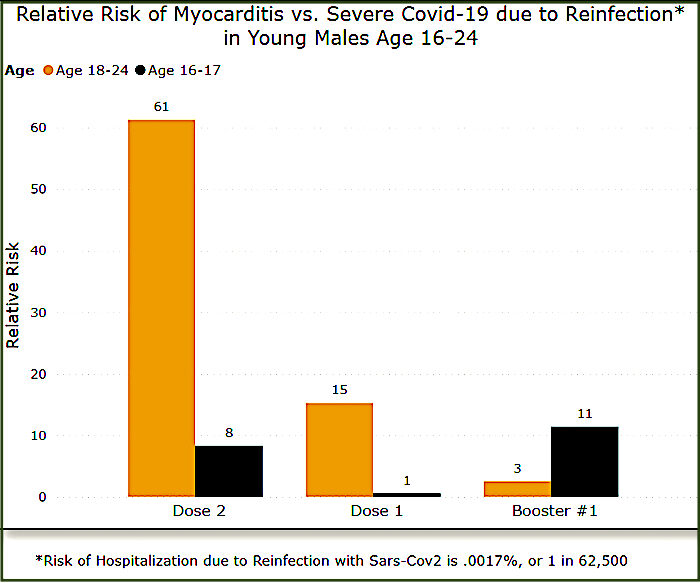On May 12th of last year, school teacher Emily Jo took her 14-year-old son Aiden to get his first Pfizer vaccine dose. The public health authorities and her son's pediatrician unanimously recommended vaccination, prompting her decision. She knew that mRNA shots caused some number of adverse events, like all vaccines, but was re-assured by the CDC and White House's public recommendation.
"The talk amongst the mainstream medical community was that vaccine myocarditis was mild and that this was very rare," she told me.
At that time, despite alarming heart inflammation reports from Israel, the CDC publicly claimed to have found no signal of myocarditis after "intentionally" investigating over 200 million administered doses.
Moreover, Emily Jo was never warned of the myocarditis risk or informed about the risk-benefit profile.
"When I took Aiden to get his vaccines at the drive-through vaccination site, there was no warning about myocarditis. We were not counseled about any side effects to be aware of."In the name of public safety, scientific innovation, and personal health, Emily Jo sent out a celebratory tweet proclaiming she and her family are "so thankful" their teenage son was able to get vaccinated.
However, her pride and relief turned out to be tragically short-lived. Two days after her son's second vaccine dose (which he got a month after his first), he ended up in the hospital after experiencing intense chest pain. He was moved to a room on the acute cardiac floor where he was found to have elevated troponin levels (a key sign of heart damage) and an abnormal electrocardiogram. Every doctor Emily Jo spoke to at the pediatric hospital Children's Healthcare of Atlanta confirmed her son had vaccine-induced myocarditis.
Given her son's dire condition, Emily worried Aidan might die or suffer from a catastrophic injury. Thankfully, after four distressful days at the hospital, Aidan troponin levels returned to baseline and he was discharged. However, this didn't mean he could return to his normal life. Aidan was unable to do physical activity for six months. Sports, hikes, and other forms of exercise were deemed too dangerous for his heart — a typical consequence of myocardial injuries. Emily Jo said:
"I had no idea how life altering 'mild' myocarditis actually is. I have a very hard time with the label 'mild' for anything that requires hospitalization and months of inactivity."The most serious concern with Aidan's vaccine injury isn't the harrowing experience itself, but the frequency at which it occurs. Virtually any substance or medication will produce a diverse range of reactions across the human population. As many commentators have correctly noted, if you administer peanuts to everyone, there will be some number of fatalities and cases of anaphylaxis.
The rare incidence of life-threatening anomalies doesn't mean that peanuts produce a net harm or should be banned altogether. Tragic interactions with any kind of externality are often exaggerated and exploited to justify irrational ideological agendas. For example, Minneapolis officer Derek Chauvin's treatment of George Floyd paved the way for radical "Abolish the Police" initiatives.
In the case of COVID-19 vaccines causing myocarditis, we aren't dealing with trivial ratios of one in a million or even one in ten thousand. Among the most robust data we have — according to Dr. Tracy Beth Hoeg (Florida Health department) and Dr. Marty Makary (Johns Hopkins University) — is from Dr. Katie Sharff (who had her young son vaccinated) and colleagues, who analyzed a wide database from Kaiser Permanente.
Going beyond other study methods, Sharff found a number of vaccine myocarditis cases that weren't explicitly labelled as such or were outside the parameters of the CDC's vaccine safety search. After performing an exhaustive search of the Kaiser medical records, Sharff and colleagues found a 1 in 1,862 rate of myocarditis after the second dose in young men ages 18 to 24. For boys ages 12 to 17, the rate was 1 in 2,650. Countries with active surveillance monitoring of medical data (which suffer from far less under-reporting than the passive system in the U.S) — such as Hong Kong — show virtually identical figures. The risk of vaccine-induced myocarditis remains elevated for men up to the age of 40.
One need not be an anti-vaccine conspiracy theorist to recognize these figures are alarmingly high.
Historically, vaccines with adverse event profiles far lower — but still deemed far too high — than the mRNA myocarditis signal have been withdrawn. The 1976 swine flu vaccine was pulled back because of a 1 in 100,000 risk of Guillain-Barre Syndrome.
An approximate 1 in 3,000 risk of vaccine myocarditis in young males would only be favorable in a cost-benefit analysis wherein the risk of disease would be considerably serious.
The pre-vaccine Covid infection fatality rate for people under 30 was 0.003%.
The vaccine myocarditis risk after dose two (0.03%) is ten times higher than the fatality rate.
Today, since the vast majority of young Americans have been previously infected with Covid once or twice, the calculus has shifted. Putting aside the question of whether it makes sense for unvaccinated people to get the primary series targeting outdated variants, the myocarditis risk (in young males) from even one dose eclipses that of hospitalizations from re-infection. Josh Stevenson — a data analyst who has co-authored multiple peer-reviewed studies on vaccine myocarditis — has designed the following bar graph comparing risks:
Using Covid hospitalization statistics instead of deaths is a more accurate comparison since Covid deaths are virtually nonexistent in healthy, young populations. Still, the differences are massive. For example, the risk of myocarditis from dose one in males ages 18-24 is 15 times higher than hospitalization from Covid re-infection. For dose two, the risk differential is a stunning 61 times greater.
Unless a young male is immunocompromised, obese, or suffering from other serious health conditions, taking any mRNA Covid vaccines carries far more risk than benefit. The best data indicate this is a fact — though this is hardly considered in mainstream media.
***
Cases such as Aidan's have prompted many honest voices in the public health community to reflect on the CDC's top-down vaccine recommendations. Dr. Anish Koka — a renowned cardiologist with his own clinic in Philadelphia — believes medical experts should have been "more careful about recommending this to low-risk patients from the very outset."
Koka Cardiology
As he explained to me over email:
"Clinical myocarditis is never mild — a recent paper of 12-29-year-olds found 25% of myocarditis patients end up in the ICU, and 1 patient needed ECMO (a modified heart lung machine) to stay alive. The long term impacts of the persistent scars that are apparent in follow-up on cardiac MRI are also unknown.Instead of mitigating risks by further spacing vaccine doses, recommending Pfizer over Moderna, and being honest about near-zero risks of severe outcomes in younger, healthy groups, Big Pharma in collusion with the government recklessly opted for universal decrees.
"It was apparent by April (of 2021) there was a real safety signal. Why didn't public health authorities make decisions starting then to at least inform the public about this potential side effect at that point. "
Looking back on the CDC and Food and Drug Administration's (FDA) possible negligence and recklessness, Khoka stated the harm perpetrated was "unconscionable."
More and more medical professionals are now speaking out on the strong likelihood that vaccine-induced myocarditis seems to occur at a rate that far exceeds deaths and hospitalizations in healthy, naturally immunized men under 40. Johns Hopkins public health professor Marty Makary recently wrote in a tweet:I had been frankly hesitant to make such a statement since it isn't scientifically rigorous, but since this topic is becoming less taboo, I will say it now: I have heard (without deliberately seeking) of several vaccine myocarditis cases in healthy, young people but have heard of zero hospitalizations and deaths.
In my last investigative article, I interviewed a 38-year-old previously healthy and incredibly fit man who unwillingly got double-vaccinated to keep his job in law enforcement.
He didn't hear the term "vaccine-induced myocarditis" until the doctor told him his diagnosis when he ended up in the hospital after almost dying from heart failure (210 beats per minute) following the second Pfizer dose:
"Working out of the gym helped clear my mind and establish discipline in my life...I can't jog, go for a hike, play tennis, or do any of the things for both my mind and body.Desh's story shows how vaccine myocarditis isn't a "just" a problem for "14-year-old boys." It's serious risk for young men broadly.
—
"I'm living with the consequences of what the government made me do, not what I chose to do," he said.
"If you don't get the vaccine, you're an outlaw," he added. "And you must be vanished to some other place in society."
—
Perhaps the most damning insight from this young man's story is the alarming frequency at which others like him have suffered. The doctor at the hospital said he was his third vaccine-induced myocarditis patient in a month-and-a-half; meanwhile, his cardiologist said he was his fourth patient at his clinic in recent weeks.
Three vaccine-induced myocarditis patients in (roughly) 60 days in a single hospital — out of 139 total major hospitals in British Columbia — suggests this problem is prevalent enough to warrant not only an end to draconian government mandates but also the halt of the administration of the vaccine in young healthy men (until more studies are conducted).
It makes little coherent sense why young males were not only permitted and recommended to get the mRNA vaccine series, but mandated by the state (as I wrote at length here). This injustice is even more egregious now that we know vaccines confer little to no long-term protection against infection.
Aidan's mother recently came across a new scientific paper showing dismal vaccine efficacy in adolescents and tweeted the following:
Thinking about the fact that Aidan got myocarditis for 30.6% transient efficacy is pretty infuriating...This Pfizer vaccine was initially sold as 95% effective. Big change.Fast-forward to today, Aidan is far from his physical condition before getting double-vaccinated. After advising him against even going for a walk for the first four months post-vaccination — and eventually allowing a return to exercise after six months — Aidan's cardiologist has cleared him for all physical activity. Emily says:
"He tires more easily and has lower endurance. He used to be able to run around and play for hours....now it's like 20-30 minutes and he gets exhausted."More than a year later, Aidan is still recovering from a vaccine that had little to provide him in the first place. Though some have shamed Emily for getting her son vaccinated, she is hardly to blame for trusting in taxpayer-funded health agencies whose sole function is to keep the public healthy and safe.
In light of the FDA and CDC's outrageous push to vaccinate everyone with the new "bivalent" booster — despite explicitly "unknown" myocarditis risks — hopefully more people will wake up and re-evaluate their blind faith in institutions who have far abandoned their ostensible mission of keeping us safe and healthy.
About the Author:
Rav Arora is a 21-year-old, independent journalist formerly writing for top publications such as The Globe and Mail and New York Post before critically covering vaccines and government mandates. Please consider supporting his fearless journalism, focusing on tragic stories of vaccine myocarditis. Read his in-depth vaccine myocarditis series here.







Reader Comments
Yes, I threw the snow balls and worse. I can't believe we used to smash pumpkins, that was just wrong!
No, not all. Just the people who spent their youths questioning authority, throwing snow balls at cars and stealing Christmas lights off of people's trees. You still have a couple of those opaque, red, incandescent bulbs, don't you?
I have some green ones...want to trade?
On May 12th of last year, school teacher Emily Jo took her 14-year-old son Aiden to get his first Pfizer vaccine dose. The public health authorities and her son's pediatrician unanimously recommended vaccination, prompting her decision. She knew that mRNA shots caused some number of adverse events, like all vaccines , but was re-assured by the CDC and White House's public recommendation.
That decision she made (if true) on behalf of her Son will haunt her because someone’s lying & she made the wrong choice.
How do you replace or repair misplaced trust ?